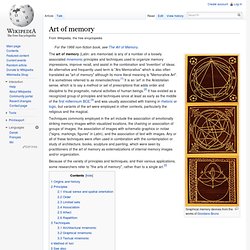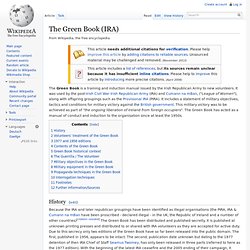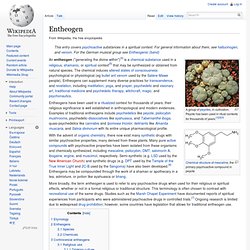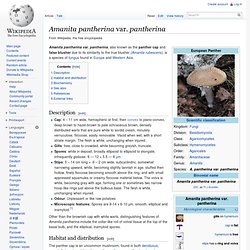

Art of memory. The art of memory (Latin: ars memoriae) is any of a number of a loosely associated mnemonic principles and techniques used to organize memory impressions, improve recall, and assist in the combination and 'invention' of ideas.

An alternative and frequently used term is "Ars Memorativa" which is also often translated as "art of memory" although its more literal meaning is "Memorative Art". It is sometimes referred to as mnemotechnics.[1] It is an 'art' in the Aristotelian sense, which is to say a method or set of prescriptions that adds order and discipline to the pragmatic, natural activities of human beings.[2] It has existed as a recognized group of principles and techniques since at least as early as the middle of the first millennium BCE,[3] and was usually associated with training in rhetoric or logic, but variants of the art were employed in other contexts, particularly the religious and the magical. Origins and history[edit] One of Giordano Bruno's simpler pieces Principles[edit] Artificial Memory Palaces - Memory Techniques Wiki. This page lists ideas about creating artificial memory palaces with the Method of Loci .

Research suggests that imaginary memory palaces are just as effective as locations that one knows well. [1] Memory Palaces from Art Check out this interesting comment : I find a book of paintings (300-500 prints -- the big art books are the best and color prints are better than black and white). Then I work through the paintings from the start, placing lines of poetry onto images within the paintings. See also the page Creating Memory Palaces from Art and using paintings as memory palaces . Memory Palaces from Software. Bottles of Djinn: Seven Forms of Hermetic Meditation. The mind all by itself is capable of many amazing operations, some which have been reintroduced to Western audiences in just the last fifty years or so by the influx of Eastern spirituality and their various meditative techniques.

Of course, all of these practices have been part of our own Western esoteric tradition for hundreds of years, but for some reason it seems easier for most people to except exotic ideas when they’re being delivered from an equally exotic, far off place. Perhaps this is why it is said that no man can be a prophet in his own land. The Green Book (IRA) Because the IRA and later republican groupings have been identified as illegal organisations (the PIRA, IRA & Cumann na mBan have been proscribed - declared illegal - in the UK, the Republic of Ireland and a number of other countries)[citation needed] The Green Book has been distributed and published secretly.

It is published at unknown printing presses and distributed to or shared with IRA volunteers as they are accepted for active duty. Due to this secrecy only two editions of the Green Book have so far been released into the public domain. Ephedra californica. An Ephedra californica cone.

Ephedra californica is a species of Ephedra, known by the common names California jointfir, California ephedra, desert tea, and cañatillo. Distribution[edit] Ephedra (genus) This article is about the genus Ephedra.

For the use of the plant in medicine, see Ephedra. In temperate climates, most Ephedra species grow on shores or in sandy soils with direct sun exposure. Common names in English include joint-pine, jointfir, Mormon-tea or Brigham tea. The Chinese name for Ephedra species is mahuang (simplified Chinese: 麻黄; traditional Chinese: 麻黃; pinyin: máhuáng; Wade–Giles: ma-huang; literally: "cannabis yellow"). Ephedra is also sometimes called sea grape (from the French raisin de mer), a common name for the flowering plant Coccoloba uvifera. Jump up ^ "Ephedrales Dumort. ". Ephedrine. Ephedrine (/ɨˈfɛdrɪn/ or /ˈɛfɨdriːn/; not to be confused with ephedrone) is a sympathomimetic amine commonly used as a stimulant, appetite suppressant, concentration aid, decongestant, and to treat hypotension associated with anaesthesia.

The herb má huáng (麻黄, Ephedra sinica), used in traditional Chinese medicine, contains ephedrine and pseudoephedrine as its principal active constituents. The same may be true of other herbal products containing extracts from other Ephedra species. History[edit] Ephedrine in its natural form, known as má huáng (麻黄) in traditional Chinese medicine, has been documented in China since the Han Dynasty (206 BC – 220 AD) as an antiasthmatic and stimulant.[2] The chemical synthesis of ephedrine was first accomplished by Japanese organic chemist Nagai Nagayoshi in 1885.
Botanical identity of soma–haoma. There has been much speculation as to the original Rigvedic Soma plant (and of the Proto-Indo-Iranian *Sauma which besides Soma is reflected in the Iranian Haoma).

Since the late 18th century, when Anquetil-Duperron and others made portions of the Avesta available to western scholarship, several scholars have sought a representative botanical equivalent of the haoma as described in the texts and as used in living Zoroastrian practice. Most of the proposals concentrated on either linguistic evidence or comparative pharmacology or reflected ritual use. Rarely were all three considered together, which usually resulted in such proposals being quickly rejected.
Candidates for the identity of soma[edit] Entheogen. A group of peyotes, in cultivation.

Peyote has been used in ritual contexts for thousands of years.[1][2][3] Amanita muscaria. Amanita muscaria, commonly known as the fly agaric or fly amanita, is a mushroom and psychoactive basidiomycete fungus, one of many in the genus Amanita. Native throughout the temperate and boreal regions of the Northern Hemisphere, Amanita muscaria has been unintentionally introduced to many countries in the Southern Hemisphere, generally as a symbiont with pine plantations, and is now a true cosmopolitan species.
It associates with various deciduous and coniferous trees. Although it is generally considered poisonous, reports of human deaths resulting from eating the mushroom are extremely rare. After parboiling—which removes the mushroom's psychoactive substances—it is eaten as a food in parts of Europe, Asia, and North America. Amanita muscaria is noted for its hallucinogenic properties, with its main psychoactive constituent being the compound muscimol. Taxonomy and naming[edit] Buttons Classification[edit] Muscimol. Muscimol (agarin, pantherine) is the major psychoactive alkaloid present in many mushrooms of the Amanita genus.
Muscimol is a potent, selective agonist for the GABAA receptors and displays sedative-hypnotic effects. Chemistry[edit] Muscimol is the psychoactive compound responsible for the effects of Amanita muscaria intoxication. Ibotenic acid, a neurotoxic secondary metabolite of Amanita muscaria, serves as a prodrug to muscimol when the mushroom is ingested or dried, converting to muscimol via decarboxylation. Biology[edit] Amanita pantherina var. pantherina. Amanita pantherina var. pantherina, also known as the panther cap and false blusher due to its similarity to the true blusher (Amanita rubescens), is a species of fungus found in Europe and Western Asia.

Description[edit] Cap: 4 – 11 cm wide, hemispheric at first, then convex to plano-convex, deep brown to hazel-brown to pale ochraceous brown, densely distributed warts that are pure white to sordid cream, minutely verruculose, floccose, easily removable. Viscid when wet, with a short striate margin. Book:Brief History of Religion. Cut Ties: Join The Mandarin Collar Society. The Sweat Lodge. ABOUT THE SWEAT LODGE and ITS USE Adapted from the notes of Hopoyv Fekseko (D. Joseph Alderson) andothers by Chetty Chapko for use by the CeremonialDiscussion Committee of Pine Arbor Tribal Town, 1997. "All things employed in the sweat rite are holy to the Native Americanand must be thoroughly comprehended ........... for the true power ofa thing or an act is found in the understanding.
" Paraphrased from Bobby Woods, Lakota (Sioux) sweat leader Introduction Several community sweat lodge participants asked for more information and explanation about sweats. Prester John. The legends of Prester John (also Presbyter Johannes) were popular in Europe from the 12th through the 17th centuries, and told of a Christian patriarch and king said to rule over a Christian nation lost amidst the Muslims and pagans in the Orient. Written accounts of this kingdom are variegated collections of medieval popular fantasy. Prester John was reportedly a descendant of one of the Three Magi, said to be a generous ruler and a virtuous man, presiding over a realm full of riches and strange creatures, in which the Patriarch of the Saint Thomas Christians resided.
His kingdom contained such marvels as the Gates of Alexander and the Fountain of Youth, and even bordered the Earthly Paradise. Among his treasures was a mirror through which every province could be seen, the fabled original from which the "speculum literature" of the late Middle Ages and Renaissance was derived, in which the prince's realms were surveyed and his duties laid out.[1] Koro-pok-guru. Koropokkuru (コロポックル?) , also written Koro-pok-kuru, korobokkuru, or koropokkur, are a race of small people in folklore of the Ainu people of the northern Japanese islands.
The name is traditionally analysed as a tripartite compound of kor or koro ("butterbur plant"), pok ("under, below"), and kur or kuru ("person") and interpreted to mean "people below the leaves of the butterbur plant" in the Ainu language. Sanskrit drama. Sports in Finland. 7 Horrific Boogeymen Used to Scare Kids Around The World. The Kappa Will Eat Your Children's Assholes One of Japan's oldest and most famous mythological beings, Kappa are "water goblins" best described as the Teenage Mutant Ninja Turtles after a lobotomy.
Seen here. Instead of a brain, these slimy duck-billed turtle people simply have a hole on their head filled with water, which undoubtedly makes them excellent problem solvers. 25 Profound Questions To Start Asking Yourself Everyday. Sept 24, 2012 by EDITOR. 3 Requirements For A Satisfying Job. I’ve been following this blog for a while and this is my first comment. Regarding the 3 requirements for a satisfying job; I’ve seen plenty of my friends bounce from one job to another trying to get their #1 requirement right, which is MONEY.
Little do they know that MONEY should not be their #1 requirement if they truly want to be satisfied (happy). Game Theory and Beyond. 6 Devious Ways Farmville Gets People Hooked. If you're on the internet at all (and you obviously are) you probably either play Farmville or get bombarded with invites from one of the 60 million people who do, and think less of them for it. You might have wondered how such a dumb Flash-based game can be hooking so many people. Mark Pincus talk at Startup@Berkeley. 6 Retarded Publicity Stunts (That Fooled Everyone) 8 Insane Ways Parents Are Politically Brainwashing Children. Help! Mom! There are Liberals Under My Bed! You can teach your children all about conservatism, indoctrinate them with religious beliefs while they're far too young to fully grasp them and dress them in all the propaganda you want, but what if that's not enough?
5 Cheap Magic Tricks Behind Every Psychic. 5 Creepy Ways Video Games Are Trying to Get You Addicted. Keeping You Pressing It... Forever. 5 Creepy Ways Video Games Are Trying to Get You Addicted. So, the headlines say somebody else has died due to video game addiction. ADV EXPERIMENTAL SOCIAL PSYCHOLOGY. Behavioral Game Design. The Norrathian Scrolls: A Study of EverQuest - (MMORPG Research, Cyberculture, MMORPG Psychology, Demographics, Statistics, Psychology, Charts, Addiction, Gender Differences, Gender Bending, Relationships, Romance, Guilds, Download) 6 Habits of Highly Annoying Public Speakers.